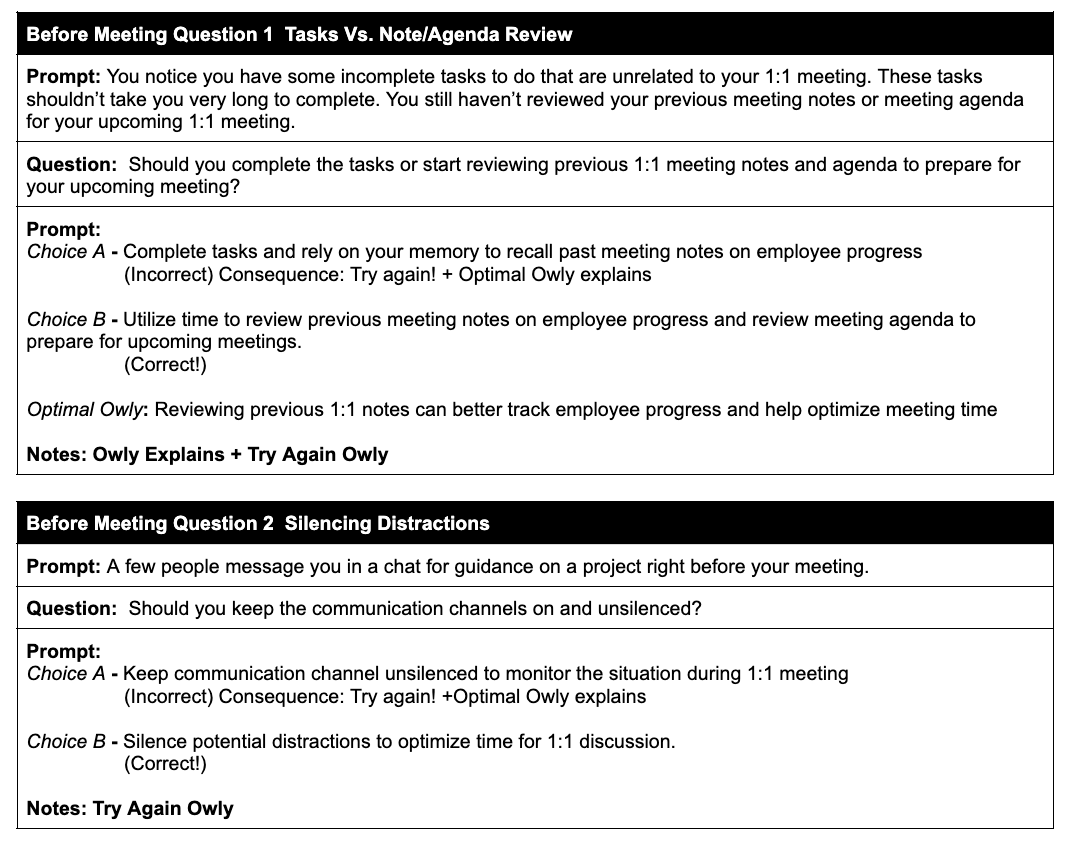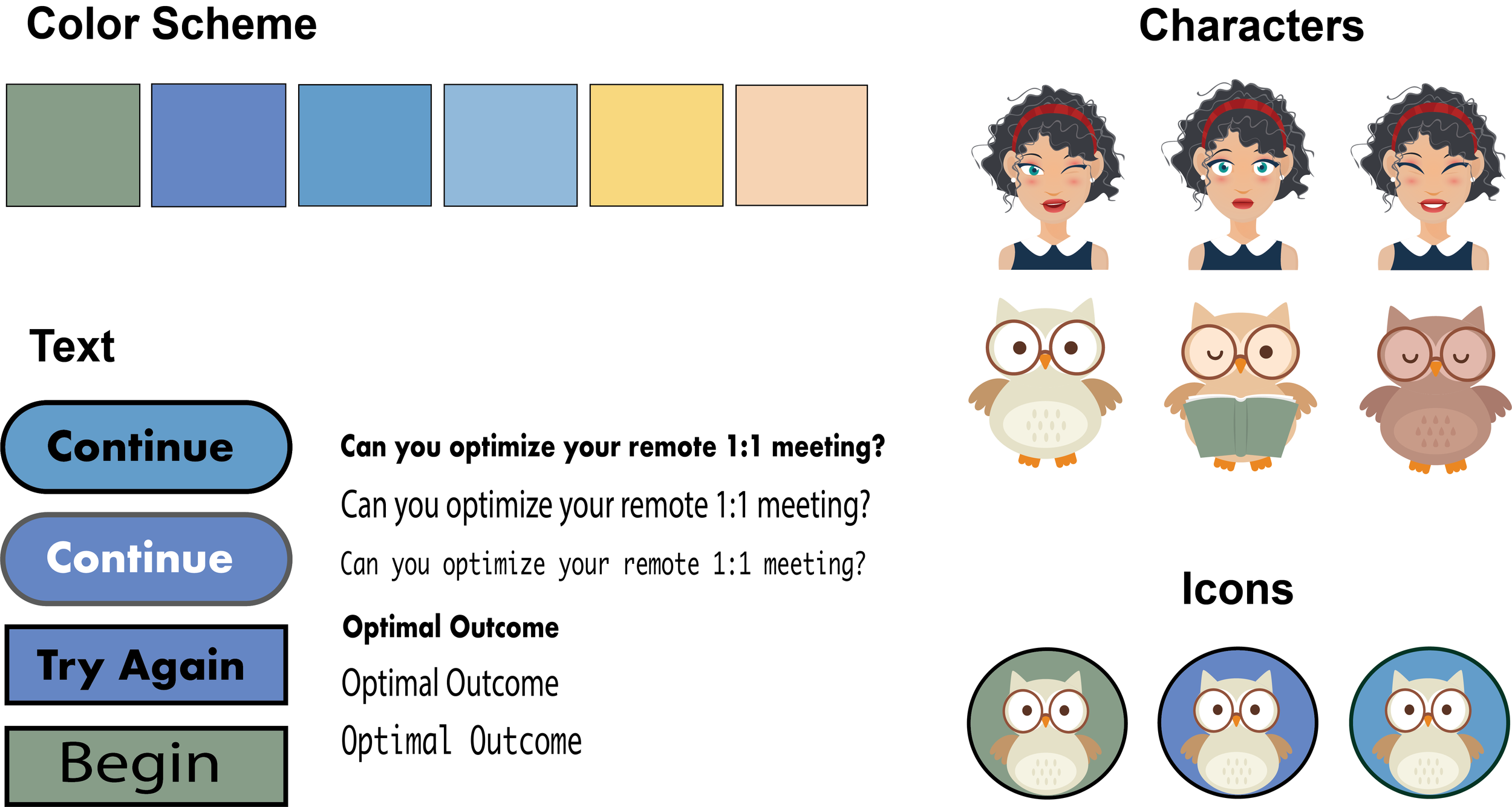Optimize Your Remote 1:1 Meeting
Overview
Audience: Managers seeking to optimize remote 1:1s with their team
Responsibilites: Instructional Design, eLearning Development, Action Mapping, Needs Analysis, Storyboarding, Visual Design, Prototyping
Tools Used: Articulate Storyline 360, Adobe XD, Adobe Illustrator, Mindmeister, Google Docs
The purpose of this eLearning simulation is to give managers guidance on optimizing their team 1:1s in a remote environment. Managers will learn to maximize their 1:1s by making informed choices to prepare, structure, and create a safe meeting space which promotes employee empowerment. By providing a risk-free learning environment, this training allows managers to explore ways to address power dynamics, promote collaborative feedback, and increase employee comfortability in meetings. The learner will utilize and explore tools to optimize 1:1s through scenario based consequences. This helps the learner connect their experience with real-world scenarios.
The Problem
Op-team-ize, Inc. (a fictitious company for this concept project) conducted an employee survey and found that employees who don’t engage in regular remote 1:1s with their managers felt unappreciated and lacked confidence in their work tasks. Employees that did have remote 1:1s with their managers felt communication blockers due to power dynamics and were selective with sharing feedback, updates, and ideas. Understanding the impact team 1:1s have on employee performance, the company decided to prioritize manager training to better optimize their team 1:1 meetings.
The Solution
After careful analysis, I determined that the problem was performance related and caused by a lack of knowledge in managers effectively running remote team 1:1 meetings. I recommended a scenario-based eLearning experience that allows managers to practice making decisions during their remote 1:1 meeting in a risk free environment. Showing managers the realistic, memorable consequences of common meeting mistakes allows the learner to practice avoiding these mistakes and apply effective strategies to better optimize meetings in real life.
The Process
Guided by the ADDIE model, I iterated steps in my process until I was satisfied with the content, visuals, and functionality of the learning experience. My process included using Bloom’s Taxonomy to write a clear objective, action mapping, drafting a text-based storyboard, creating visual mockups, and building prototypes before achieving full development.
Objectives and Bloom’s Taxonomy
Using Bloom’s Taxonomy, I developed clear, measurable learning objectives for this learning experience. I analyzed key information for the learner to remember, understand, apply, analyze, evaluate, and create.
Action Mapping
Guided by Cathy Moore’s strategic action mapping process, I worked with a Subject Matter Expert (SME) to develop the overall goal for this learning experience. I worked with the SME to brainstorm observable tasks and behaviors the learners would need to engage in to meet the performance goal. We categorized performance tasks into actions and sub-actions. After thoughtful analysis, we identified which tasks, actions, and behaviors would best contribute to the business goal. The results from this analysis largely influenced the focus of the content, and my design to build the learning experience.
Action mapping is a key part of my design process because it allows me to provide meaningful and relevant learning content to the learner as well as ensure client needs are being met. Prioritizing actions reduces cognitive overload, offers opportunities for diverse learning, and helps the learner retain crucial information associated with performance goals.
Text-Based Storyboard
Once key learning actions and behaviors were identified, I began working on a text-based storyboard to build a cohesive narrative. I framed the scenario as a manager conducting a remote 1:1 meeting with a member of their team. The storyboard includes choice outcomes and consequences. As the learner goes through the scenario, each option proposes distractors and a correct choice. If the learner chooses the correct action, they will see the positive consequence and progress in the scenario. If a wrong answer is selected, the learner will experience real-life consequences and a mentor explanation. Users are also provided with a “try again” button which leads them back to the question. An employee comfortability meter is also incorporated in the text-based storyboard to indicate immediate feedback for learner choices.
I consulted with the SME to ensure each scenario was grounded in reality. We prioritized mirroring realistic experiences during a remote 1:1 meeting scenario to help create authentic consequences which provided the “why” for decision making.
Visual Mockups
Once the text-based storyboard was finalized, I began creating visual mockups for the learning scenario.
Color Scheme: I created a custom color palette with additional visual assets and typefaces based on the company’s color schemes.
Visuals: In order to maintain a consistent visual style, I used Adobe Illustrator to modify various assets to create custom visuals for each element. I created a style guide to ensure that I was keeping fonts, colors, spacing, icons, and characters consistent while developing the learning experience.
Design Layout: I then created slides in Adobe XD to experiment with different visual elements and layouts. I developed mentor, question, and scenario consequence slides. I iterated on these slides until visuals and learning content was polished and immersive for the learner.
Interactive Prototype
I used a combination of Adobe XD and Articulate Storyline 360 to create an interactive prototype. I first tested the prototype in Adobe XD and then further developed it in Articulate Storyline 360. The prototype included several interactive slides which consisted of the title screen, introductions to the mentor and character, and showcased scenario questions with correct and incorrect prompts. I added interactive triggers, transitions, and animation to the prototype. I also included the first iteration of the employee’s comfortability meter for learners to gauge the character’s reaction to choices.
Once I felt satisfied with the look and feel of the prototype, I shared it with peers and mentors in the learning and development community. Overall the reception was positive and I made minor adjustments to edit audio, tighten transition times, and further develop the employee’s comfortability meter. I continued testing the prototype after applying the necessary adjustments from feedback I received. I migrated the project to full development once I was satisfied with the visuals and functionality of the prototype.
Full Development
I developed the final project in Articulate Storyline 360 and continued to add custom visuals, sounds, and animations to the rest of the remaining slides. I included sound effects to serve as audible feedback for learner responses and adjusted triggers to offer a smooth learning experience for the user.
Features
Custom Visuals: I created and edited visuals in Adobe Illustrator to create an immersive experience for the user to feel they are experiencing a remote 1:1 meeting. I designed supporting visuals and icons for various scenarios throughout the learning experience as well as the question and answer slides. This included recoloring different elements, resizing, modifying, adjusting layers, and merging assets.
Gamification: This learning experience includes an employee comfortability meter to contextualize the emotions of team members during 1:1 meetings. The meter increases or decreases based on answers submitted by the learner. This provides immediate feedback to the user and builds empathy awareness for real-world 1:1 scenarios.
Mentor: The learner can access a mentor named “Optimal Owly” to assist them in optimizing their 1:1 meeting. Optimal Owly provides suggestions and guidance to the user when support is needed to make decisions during the remote 1:1 meeting scenario. I created a custom icon for the learner to access the mentor throughout the learning experience.
Choice Feedback: As the learner navigates the learning experience they receive immediate feedback for their choices. When a correct answer is selected, user actions are reinforced by sounds, the gamification meter, and character feedback. If the learner chooses an incorrect response, character reactions, sounds, and the gamification meter reflect consequences to the decision. An explanation provided by the mentor also guides the learner to more appropriate alternatives if an incorrect answer is selected. Learners are prompted to try again until they are able to identify the best solution to the scenario.
Results and Takeaways
I shared the completed project with my network and was overwhelmed with the responses.
“I loved the mentor and the creative dialogue from the characters. The design is well thought out and the experience shared a lot of helpful content.”
“This has given me some ideas on how I can improve as a manager. I want to use some of the things I learned from this learning experience and apply it to my team.”
“The content is really informative and the visuals look really professional. The whole experience felt very immersive and polished.”
Throughout this process, I gained several important takeaways. I increased my tool knowledge, problem-solving and story development skills. More importantly, I developed a deeper appreciation for user feedback. Different perspectives helped me realize critical information and details that I did not consider in my prototypes. These details became essential parts of the learning experience and helped increase functionality to support learner needs.
Building this scenario-based learning experience allowed me to work with a SME and collaborate with my network. It also gave me the opportunity to expand my knowledge with instructional design programs and tools such as Articulate Storyline 360 and Articulate Rise. I enjoyed creating this learning experience as a helpful resource to support modern workplace trends.
I would like to continue building and improving this concept piece by including some of the following elements.
Expanded Situations: This concept project only features one employee meeting scenario. A fully expanded learning experience would offer multiple meeting scenarios with different team members.
Scenario Branching: I would like to further develop the learning experience by incorporating scenario sequencing for incorrect answers. The learner would experience a realistic outcome when the meeting is poorly conducted. This approach would highlight potential real-world consequences.
xAPI: I would like to continue iterating this concept project by including xAPI to track learner behavior. Data would be collected for incorrect/correct responses, mentor prompts, and time to completion to adjust the learning experience.














